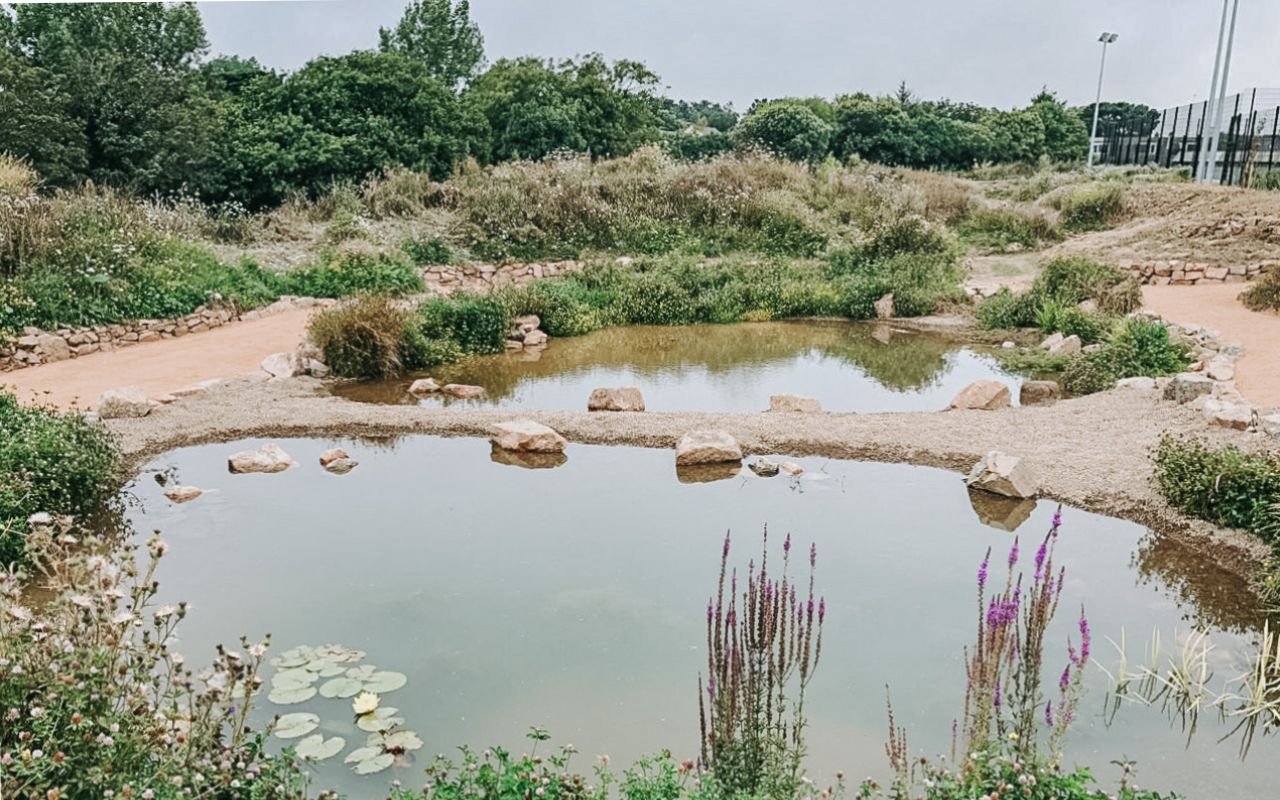Wildlife Zone - Les Quennevais School
Project Area
Ecology & Habitats
Specialisms
Mitigation/Protection, Environmental Gain, Habitat Creation
Year
2021
The school was to be built on agricultural fields which had been grazed for decades, with favourable areas of rough grassland habitat present on site. The current habitat included dry stone walls and tussocky grassland harboured green lizards, toads, slow worms and small mammals. The hedgerows and grassland provided foraging and commuting habitat for birds and bats.
The entire area was re-zoned to allow for the new school to be built. Ecological features such as native hedgerows needed protection from the works. Other ecological features such as dry stone walls needed to be carefully dismantled by hand and protected wildlife captured and translocated.
The design team needed and wanted to demonstrate environmental gain at the site, as this areas was designated as ‘Green Zone’ in the Island plan before being re-categorized to allow the school to be built. Ensuring dedicated wildlife areas were safe for children as well as being good for wildlife was vital.
Fortunately Jersey Property Holdings (JPH) came to us at a very early stage of planning so that we could get our surveys done to help inform the design of the site and discuss the programme of works regarding the site strip well before Planning permission was sought.
We worked closely with the Department of the Environment to ensure a satisfactory Species Protection Plan could be implemented, which included the following;
Short-term mitigation
Timing of works to avoid nesting birds and breeding amphibians and reptiles.
Creation of fenced-off temporary receptor sites to translocate protected wildlife into (prior to creation of the final Wildlife Zone).
Ecological Method Statements and tool box talks with contractors before the site was stripped.
Ecological supervision of other ‘hot-spot’ areas of site for wildlife.
Removal of the dry-stone wall done carefully by hand, and protected wildlife translocated to receptor site. Granite stockpiled for later re-use.
Directional vegetation cut of the site to flush remaining wildlife out of the area. Directional ‘turf strip’ of the site to further flush out remaining wildlife.
Native hedgerow and tree-line retained along the length of the southern boundary – setting up of root protection zones around these trees.
Appointed as ‘Ecological Clerk of Works’ for the duration of construction works to ensure the mitigation and Species Protection Plan implemented in full.
The new School is a BREEAM accredited building, demonstrating sustainability and environmental and ecological compliance.
Long-term enhancements
Creation of a large Wildlife Zone at the west of the site, close to existing favourable habitat at the sand dunes and Creepy Valley. The Wildlife Zone includes two wildlife ponds, wildflower banks and dry stone walls (from granite taken from original dry-stone wall on site). Footpath route and outdoor classroom areas created to facilitate outdoor learning and access to the area for the children to enjoy. Disabled access to the wildlife ponds.
Management Plan written for the Wildlife Zone to ensure it is looked after in a way that will provide maximum wildlife benefit whilst being a useable space for the School. Recommendations on the landscaping scheme to ensure it included wildlife attracting species and had no invasive plants. Recommendation to include a native hedgerow around the entirety of the site. Integrated bat and bird boxes ‘built in’ to the external walls of the sports hall (next to the wildlife zone) to provide nesting / roosting habitats for these species.
The two wildlife ponds immediately attracted an abundance of wildlife including birds, bats, toads, dragon-flies, birds and insects. The wildflower banks are alive with butterflies, bees and other insects. The wildlife zone is a fantastic outdoor learning space and resource for the school.
Long-term bat and bird roosting / nesting habitat incorporated into the building – success to be monitored following completion. The landscaping scheme we advised on has led to a superb range of wildlife-attracting species, a complete hedgerow and tree-line around the school, and ‘green screening’ of the school in time.
During trapping and translocation and ecological supervision of initial vegetation clearance works we translocated toads, slow-worms, green lizards and bank voles out of the works area into dedicated safe areas for wildlife
Since planting has matured and the wildlife zone has settled, this scheme has a demonstrable ecological and environmental gain. Protected the wildlife was safeguarded in the short term, and suitable habitat created and maintained for their long-term survival in this area.
_____
Richard Cheal, Head of Capital at Jersey Property Holdings, said ‘Nurture Ecology were thorough in their approach enabling the development to progress in the safest of ways. The wildlife mitigation plans put into place have worked extremely well and Jersey Property Holdings are satisfied that the wildlife in the area will continue to thrive.’
Highlight Projects
















